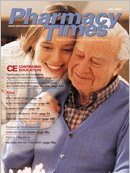Publication
Article
Pharmacy Times
Acne Products
Author(s):
Acne Products
Acne is one of the most prevalent dermatologic conditions in the United States, affecting to some degree ~85% of individuals between the ages of 14 and 24 years.1,2 It typically develops in males from 12 to 18 years of age and in females from 15 to 17 years of age.1 In addition, statistics show that 40% to 54% of individuals older than 25 years of age have some degree of acne.1 In general, acne can be classified as follows: Noninflammatory acne - whiteheads (closed comedones) and blackheads (open comedones)Inflammatory acne - pimples that may rupture to form inflammatory lesions that are raised, reddened areas on the skin (papules)1,2In many cases, individuals may exhibit a combination of comedones, papules, and pustules. Although acne typically occurs in the facial area, chest, and back, where the sebaceous glands are the most prominent, it also can manifest itself on other areas of the body, such as on the neck and upper arms.1 Many environmental, physical, or emotional factors may precipitate or exacerbate acne. These factors include the following1,3:CosmeticsHumidity or exposure to dirtPhysical irritation from occlusive clothing, headbands, helmets, etcPremenstrual changes or hormonal changesCertain medications, such as phenytoin, isoniazid, phenobarbital, lithium, quinine, rifampin, and steroidsStress and anxietyPharmacologic Treatments
A plethora of topical OTC acne products are available for treating mild-tomoderate acne. It is estimated that 30% of individuals use these products.3 They are available as single-entity or combination products and contain such active ingredients as benzoyl peroxide, salicylic acid, or sulfur.Benzoyl Peroxide
Benzoyl peroxide is the most effective and most commonly used agent. It is typically the agent of choice for noninflammatory acne. It exerts its pharmacologic action by decreasing Propionibacterium acnes and removing dead cells from the skin to prevent comedones.1,4Products include gels, lotions, cleansers, creams, masks, and soaps in various concentrations. They are not all equivalent, however. The gel formulations are considered more effective, because the drying effect of the alcohol gel base may augment the effectiveness of benzoyl peroxide.1Pharmacists should inform patients of the adverse effects associated with the use of benzoyl peroxide products. The primary adverse effect is excessive dryness of the skin. This agent also may cause stinging and burning. It may bleach hair, towels, or clothing, so users should be advised to exercise caution. 1,4 Patients should continue treatment for at least 4 to 6 weeks to optimize therapeutic effect. They should seek medical advice if no improvement is seen after 6 weeks or if they experience adverse effects.1Salicylic Acid
Salicylic acid products are classified as mild comedolytic agents and are available in concentrations that range from 0.5% to 2%.1 These products aid in the correction of the abnormal shedding of skin cells, as well as unclogging pores to treat or prevent acne lesions.4 They are used mainly as cleansers and then rinsed off.Sulfur
Sulfur found in topical acne products is used as a keratolytic and antibacterial agent.1 It is found in various products in concentrations that range from 3% to 10%. These products typically are used 1 to 3 times daily.Due to the unpleasant odor, sulfur is infrequently used as a single entity. It is commonly found in combination products that also contain resorcinol.
The Role of the Pharmacist
Pharmacists can be a fundamental resource for patients seeking guidance on the selection of OTC acne treatment products. Prior to recommending any such products, pharmacists should ascertain whether self-treatment is appropriate and should advise individuals with severe cases to see a dermatologist.
When counseling about acne products, pharmacists should ensure that patients clearly understand their proper use.
In addition, pharmacists can suggest preventive as well as nonpharmacologic measures that may minimize acne outbreaks. It is important for pharmacists to give patients the following tips:Do not pick or squeeze acne lesionsAlways follow the proper protocolregarding the use of the productsEstablish and adhere to a daily regimen that includes cleansing the skin at least twice a day with a soft wash cloth, using a facial soap, preferably without moisturizing oils, and warm water
Examples of OTC Acne
Products
Benzoyl Peroxide ProductsClean & Clear Persa-Gel 10, Maximum StrengthClearasil Vanishing Acne Treatment CreamNeutrogena On-The-Spot Acne Treatment, Vanishing FormulaOxy Acne WashPan Oxyl GelStri-Dex Benzoyl Peroxide Power PadsZAPZYT Maximum Strength 10% Benzoyl Peroxide Acne Treatment GelSalicylic Acid ProductsBior? Blemish Fighting Ice CleanserClean & Clear Advantage Acne Spot TreatmentClearasil Ultra Daily Face WashNeutrogena Rapid Clear Acne Eliminating GelNoxzema Triple Clean PadsOxy Daily Cleansing Pads, Focus: BlackheadsStri-Dex Maximum Strength PadsSulfur ProductsSulpho-Lac Acne Medication CreamSulpho-Lac SoapCombination Products (contain sulfur and resorcinol)Acomel CreamClearasil Adult Care Acne Treatment CreamReferences
- Berardi R, Kroon LA, McDermott JH, et al, eds. Handbook of Nonprescription Drugs. 15th ed. Washington, DC: American Pharmacists Association; 2006. Chapter 38.
- Acne Vulgaris. Merck Manual Online Medical Library Web site. Available at: www.merck.com/mmpe/sec10/ch111/ch111b.html. Accessed May 8, 2007.
- Acne Statistics. The Acne Resource Center Online Web site. Available at: www.acne-resource.org/understanding-acne/acne-statistics.html. Accessed May 9, 2007.
- Over-the-Counter Acne Products. AcneNet Web site. Available at: www.skincarephysicians.com/acnenet/treatotc.html. Accessed May 9, 2007.







